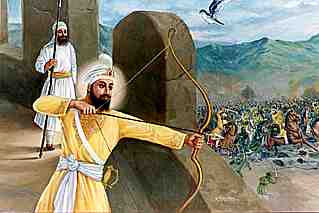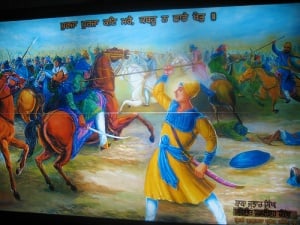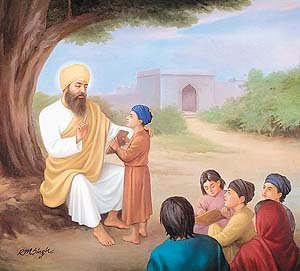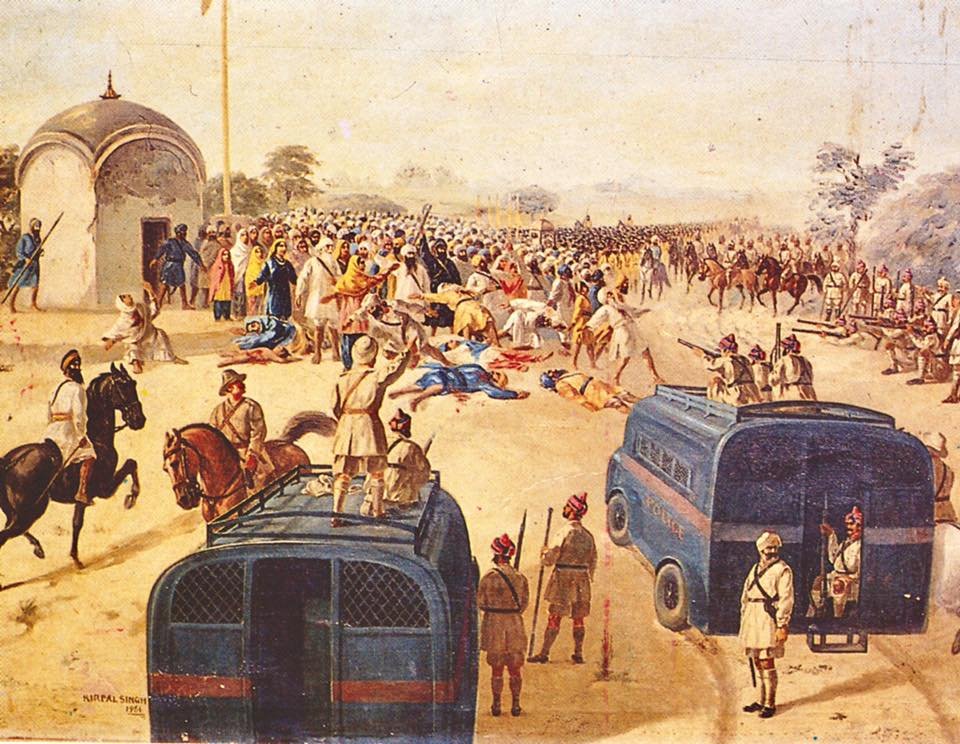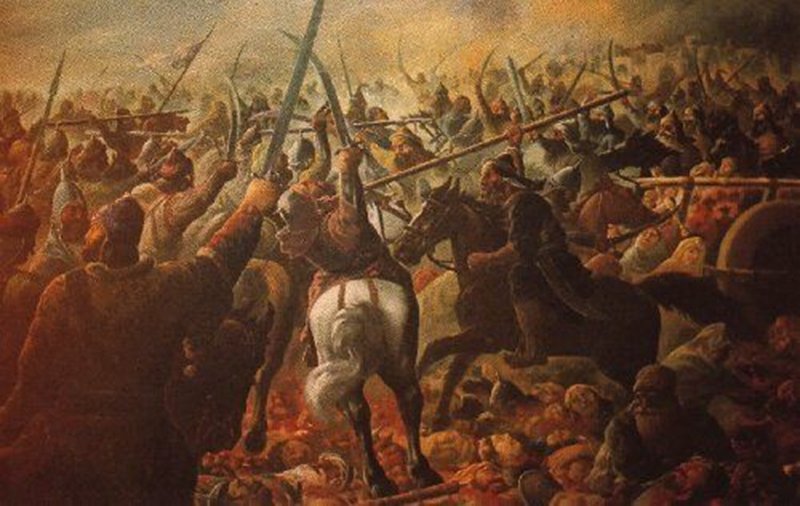|
Guru Tegh Bahadur Ji, the youngest of the five sons of Guru Hargobind Ji, was born in Amritsar in the early hours of April 1, 1621. As the news spread at daybreak, Sikhs hurried to the presence of Guru Hargobind to offer their felicitations. The Guru himself went to see the child, accompanied by two of his Sikhs, Bidhi Chand and Jetha. As he set his eyes on him, he predicted auspiciously. In the words of the Garbilas Chhevin Patshaili, he said, “Of my five sons, he shall take the of five of Guru. He shall protect the weak and relieve their distress. This shall be his principal mark.” Guru Hargobind called the child Tegh Bahadur, Mighty of Sword. The mother, Mata Nanaki, felt happy to hear her son so named. Much charity was distributed and the rejoicing continued for several days.
Owing to a minor skirmish with a Mughal force, Guru Hargobind Ji removed his family from Amritsar to the anonymity of a nearby village, called Jhabal. Tegh Bahadur was carried by Mother Nanaki in a palanquin. From Jhabal, Guru Hargobind Ji travelled to Goindwal, sacred to theThird Guru. Goindwal was one of the important Sikh towns in the Punjab. Some other places then well known in Sikh geography were Khadur Sahib, sacred to the second Guru, Tarn Taran, Sri Hargobindpur and Kartarpur, all three founded by Guru Arjan Dev Ji, the Fifth Guru, Talwandi, birthplace of Guru Nanak Dev Ji, Dera Baba Nanak, Darauli and Kiratpur, founded by Guru Hargobind. Similarly, there were towns and villages made famous by the leading Sikh families who lived there. Some of the more prominent among these were Ramdas (Bhai Buddha), Sur Singh (Bhai Bidhi Chand), Bhai Rupa (Rup Chand), Kangar (Rai Jodh) and Baba Bakala (Bhai Mehra). As they reached Goindwal, Guru Hargobind Ji, his family and Sikhs made ablutions in the baoli built by Guru Amar Das Ji. Tegh Bahadur, then barely two, was bathed with the holy water. Ablutions were repeated the following morning before Guru Hargobind left for Kartarpur. The family were left in Goindwal on the persuasion of Baba Sundar, great-grandson of Guru Amar Das Ji. Upon his return to Amritsar, Guru Hargobind recalled the family from Goindwal. As says the Sri Gur Pratap Suraj Granth, four of the Guru’s sons greeted their father by touching his feet. The youngest, Tegh Bahadur, arrived carried on her arms by his sister, Bibi Viro.
Tegh Bahadur was brought up in the approved Sikh style. As a young boy, he was placed under the teaching of Bhai Buddha Ji and Bhai Gurdas Ji. The former supervised his training in archery and horsemanship and the latter taught him the old classics. Tegh Bahadur made rapid progress and showed early promise of mastery in both fields. He also gave evidence of a deeply mystical temperament by his prolonged spells of seclusion and contemplation. This strain of his genius is best expressed in his superbly sublime poetry preserved in the Guru Granth Sahib Ji. The father’s favourable prophecies continued. Mother Nanaki, though pleased inwardly, often wondered how Tegh Bahadur, quiet and humble and devoid of all ambition, would attain the rank Guru Hargobind had predicted for him. But there was no doubt that he was his father’s favourite and that mighty events awaited him.
To quote the Sri Gur Pratap Suraj Granth, “Tegh Bahadur visited Guru Hargobind but occasionally; yet he received more consideration than anyone else. Usually, he came but once in a month. He would step in softly with his eyes turned to the ground in modesty. Thus he would bow low to the Guru’s feet. Guru Hargobind received his gentle son with words of affection and seated him sometimes by his side and sometimes lifted him up on to his knee… “But Mother Nanaki’s perplexity was not abated. She knew that her son, Tegh Bahadur, maintained no contact with the masands, nor did he supervise the household. One day she directly questioned Guru Hargobind why he treated Tegh Bahadur with such attention. The Guru answered, ‘I shall unlock the mystery for you. Tegh Bahadur can suffer what none other can. His forbearance is unsurpassed. He is master of many virtues. None else is there like him in the world. This is one reason which entitles him to acknowledgement. Second, a son will be born to him who will be mighty of limb and be the vanquisher of foe. He will take part in many a battle. He will excel in both valour and compassion. He will bring fame to the House of Guru Nanak, the world teacher.”‘
I The next several years were spent in Amritsar until it became time for Suraj Mall to marry. Tegh Bahadur joined his brother’s wedding occasion and, in the description of the Gurbilas Chhevin Patshahi, he was escorted by the devout Bhai Bidhi Chand. At Suraj Mall’s wedding which took place at Kartarpur on April 23, 1629, Bishan Kaur, one of the bride’s guests, chose Tegh Bahadur for her own daughter. Confidentially she spoke to her husband, Lal Chand, “Handsome beyond words is the Guru’s son. Though barely eight years old, far excelling is his fortune. Our own daughter is five. We must act quickly and waste no time.” They took the proposal to Guru Hargobind. Bhai Gurdas was sent to Tegh Bahadur whose answer was characteristic. He gently said that he would abide by the word of his father. The same day, he was affianced to Gujari, daughter of Lal Chand and Bishan Kaur. In Amritsar, Mother Nanaki received him with redoubled joy.
On February 4, 1633, took place the marriage of Tegh Bahadur. Relations and Sikhs congregated in Kartarpur from Goindwal, Khadur, Amritsar, Mandiali, Batala, Kangar, Bhai Rupa, Malla, and other places. Tegh Bahadur was dressed in yellow for the occasion. He wore a wreath on his forehead and an ornamented umbrella was unfolded over him. In deference to an old Punjabi scruple, the party dispensed with carriages and preferred to walk owing to the fact that the bride belonged to their own town. In the words of Bhai Santokh Singh, “Most splendid looked Tegh Bahadur. Both men and women felt fascinated by his looks. He was tall like his father. Handsome as the moon was his face. He was long of limb and broad-chested…and he walked with gentle, graceful steps.” “Like bridegroom like bride,” says the Gurbilas Chhevin Patshahi. “Gujari is by destiny made worthy of Tegh Bahadur in every way.”
Old texts record that Tegh Bahadur took part in the battle of Kartarpur on April 26, 1635. This was the last major conflict his father, Guru Hargobind Ji, had to engage in. According to the Sri Gur Pratap Suraj Granth, Guru Tegh Bahadur Ji, riding his horse, made bold sallies in all directions. Mata Nanaki Ji and her daughter-in-law watched his feats of arms from the top of their house. When word was sent to him to retire, he, like his brothers, answered that it was not proper to turn one’s back on the battlefield. Tegh Bahadur was then fourteen years old. After the battle of Kartarpur, Guru Hargobind Ji, Nanak VI, went to live at Kiratpur. For Tegh Bahadur this meant nine years of uninterrupted happiness in the company of his father. As was his wont, “he remained always saturated in the remembrance of God and spoke but little.” When his time came near, Guru Hargobind Ji asked Nanaki to go and live in the village of Bakala. Guru Hargobind Ji appointed his elder son, Guru Har Rai Ji as next guru. Guru Tegh Bahadur Ji and his brothers were present at this occasion. Guru Tegh Bahadur Ji and his wife Mata Gujari Ji shifted to Bakala. It was at Bakala when he heard about the passing away of Guru Har Rai Ji and appointment of Guru Har Krishan Ji as Nanak Eight. It was also at Bakala when he heard about his appointment as ninth guru through Makhan Shah and other Sikhs.
Three successive visits were made to Kiratpur. On August 21, 1664, Guru Tegh Bahadur Ji went there to condole with Bibi Rup Kaur Ji upon the passing away of her father, Guru Har Rai Ji, and of her brother, Guru Har Krishan Ji. The second visit was on October 15, 1664, at the death on September 29, 1664, of Mata Bassi, mother of Guru Har Rai Ji. A third visit concluded a fairly extensive journey through Majha, Malwa and Bangar districts of the Punjab. The first halt during this journey was at Amritsar, followed by halts at Tarn Taran, Khadur Sahib and Goindwal, all of long-standing sanctity in the Sikh tradition. Crossing the Beas and Sutlej rivers, Guru Tegh Bahadur Ji arrived in the Malwa. He visited Zira and Moga and reached Darauli. He then sojourned in the Lakkhi Jungle, a desolate and sandy tract comprising mainly present-day districts of Bhatinda and Faridkot. According to the Guru kian Sakhian, Baisakhi of 1665 was celebrated at Sabo-ki Talwandi, now known as Damdama Sahib. This journey took Guru Tegh Bahadur up to Dhamtan, near Jind, from where he returned to Kiratpur. On May 13, 1665, Guru Tegh Bahadur went to Bilaspur, farther up in the hills. This was to attend the mourning for Raja Dip Chand of Bilaspur. He was accompanied on this journey by his mother, Mata Nanaki, Mata Sulakkhni, widow of Guru Har Rai Ji, Mata Hari Ji, wife of Suraj Mall, Bibi Rup Kaur, daughter of Guru Har Rai Ji, and Dip Chand and Nand Chand, sons of Suraj Mall.
The Dowager Rani Champa of Bilaspur offered to give the Guru a piece of land in her state. The Guru bought the site on payment of Rs 500. The land consisted of the villages of Lodhipur, Mianpur and Sahota. Here on the mound of Makhowal, Guru Tegh Bahadur Ji raised a new habitation. The ground was broken on June 19, 1665, by Baba Gurditta Randhawa. Karahprasad was distributed after the ceremonies. The new village was named after Mother Nanaki. Chakk Nanaki later became famous as Anandpur Sahib.
Like his predecessors since the days of Guru Hargobind Ji, Guru Tegh Bahadur Ji maintained the marks of worldly dignity. But he himself lived austerely. Sikh documents, or any other, make no mention of a clash with the ruling power having occurred during his time. yet by his teaching and by his prolonged travels across the country, he created a new energy and environment for Sikh living. He was especially sensitive to the peoples’ suffering and taught them to be fearless.
At Dhamtan, Guru Tegh Bahadur Ji was received by Bhai Daggo with exceeding joy . He put him up in the new house he had constructed. The Guru showered his blessings upon him: “For meeting me with presents, milk shall abound in thy house. Minister to the Sikhs and devotees, and remain with us during our stay in this place.” Bhai Pheru was another of the Sikhs who unremittingly served the Guru and the Sikhs. He was so thoroughly devoted to his duty that he never allowed himself leisure to open his big turban and comb his hair. Guru Tegh Bahadur Ji conferred upon him the penegyric: “Clean is thy beard, Bhai Pheru; durable is thy devotion; virtuous are thy actions; thou shalt be reckoned of consequence in the world. The Guru is a sacrifice unto thee, Bhai Pheru!” The festival of Diwali brought to Dhamtan Sikhs from far-off places. They felt blessed by a sight of the Guru and faithfully received his instruction. On November 8, 1665, Guru Tegh Bahadur Ji reached Delhi. Rani Pushpa Devi of Amber was his host. Her family had reverenced the House of Guru Nanak Dev Ji since the days of the Sixth Guru, and her son, Kanwar Ram Singh, now attended upon the holy guest. Further journey lay through Mathura, Agra, Allahabad, Banaras and Sasaram. The Guru was drawn to Sasaram by the love of a Sikh, called Phaggo. Phaggo was convinced in his heart that the Guru would respond to his devotion and had, in anticipation of a visit, built a new house with a high entrance. His wish was that the Master should ride into the premises without having to dismount his horse. He cleaned the house every day and locked it, for he had vowed not to live in it until the Guru had visited it. Guru Tegh Bahadur Ji answered his wish and, on reaching Sasaram, entered on horseback the house dedicated to him.
Guru Tegh Bahadur Ji travelled on to Patna. There he spent the rainy season. At Patna was born his only son, then called Gobind Das. But he had by that time left the city acceding to the wishes of sangats in remoter districts. Dacca was the seat of an old Sikh sangat. Here the elderly mother of the local masand, Bulaki Das, eagerly awaited the Guru’s arrival. She had spun cotton with her own hands and made a dress for him. On reaching Dacca, Guru Tegh Bahadur went straight to where she lived. For the old woman, this was like a dream come true. she felt rejoiced to seat the Guru on the divan she had kept for him and to present him with the dress she had made. The entire sangat came to see the Guru singing the sacred sabads. Guru Tegh Bahadur Ji greeted them by calling Dacca “the citadel of Sikhism.” He advised them to build a new dharamsala, assemble in it for kirtan and celebrate the holy festivals. “Thus will you be liberated; thus will your sorrows be cancelled.”
Raja Ram Singh of Amber, who had been sent on January 6, 1668, from Delhi by Aurangzab with an expedition to Assam, overtook Guru Tegh Bahadur in Dacca. His mother, Pushpa Devi, had exhorted him to seek the Guru’s help in his enterprise. The Raja, himself a devoted disciple, was pleased to see Guru Tegh Bahadur Ji. He felt doubly blessed when the Guru accepted his entreaty to accompany him on the campaign. Towards the close of 1668, they set out for Assam, crossed the Brahmputra and reached Dhubri, which had also been visited by Guru Nanak Dev Ji during his travels in eastern India. Guru Tegh Bahadur marked out the spot where the First Guru had sat. People thronged to see him. A local chieftain, Raja Ram, came to seek blessing for a son. His wish was fulfilled and, as Sikh records tell, the son, named Ratan Rai, became a disciple and visited Guru Gobind Singh Ji at Anandpur with presents. Raja Ram Singh who was encamped at some distance from Guru Tegh Bahadur Ji clashed with the Ahom ruler, Chakradhwaj Singh. The issue remained undecided and, according to Sikh chronicles, the Guru brought about peace between the warring forces. Guru Tegh Bahadur Ji travelled as far as Hajo: a modern researcher traces the name of a nearby hillock, Teghpur or Tegh Parbat, to his visit.
Hajo was the farthest Guru Tegh Bahadur Ji travelled. The homeward journey began late in 1669. It was faster than the outward journey. The longest halt was at Patna where the Guru rejoined his family and saw for the first time his son, Gobind Das. At parting, the Guru instructed the family to return to Punjab and await his arrival at Lakhnaur, near Ambala. He himself proceeded to Delhi. In the entourage on this journey was his faithful Muslim follower, Nawab Saif Khan. On the evidence on the Bhatt Vahi Talauda, Guru Tegh Bahadur Ji arrived in Delhi on June 20, 1670. He put up in the dharamsala of Bhai Kalyana where disciples and followers flocked in large numbers to obtain his blessing. Rani Pushpa Devi came along with her daughter-in-law and felt relieved of her anxiety to hear of the well-being of her son, Raja Ram Singh.
Guru Tegh Bahadur’s son, Gobind Das, had reached Lakhnaur in the care of his mother and grandmother. In this village lived Mehar Chand, Mata Gujari’s brother. Guru Tegh Bahadur Ji arrived there from Delhi and proceeded to Chakk Nanki, or Anandpur with his whole family.
Kashmiri Brahmins, led by Pundit Kirpa Ram came to Guru Tegh Bahadur Ji at Anandpur in 1675 for protection against atrocities of Aurungzeb. They had faced stiff taxes, atrocities, cruelty under muslim Mughal governor of Kashmir. Honour of their daughters was being lost and they were losing their religion to the fanatic zeal and proletyzation activities of Islamic crusaders. They asked for a solution. Guru replied “Such activities can only be stopped by a sacrifice of a great person”. Just then 8 years old son of Guru Tegh Bahadur Ji Gobind Rai (Later Gobind Singh) came along and saw his father in deep thoughts. He enquired about the reason. He offered a possible solution by saying “who else is greater then you, O father”. Guru Tegh Bahadur Ji knew immediately about his Dharma. He told Kashmiri Brahmins “Go tell Aurungzeb that if they can convert your Guru then you will all become Muslims.” Kirpa Ram obliged and Aurungzeb issued summons for Guru. Guru performed the ceromany and declared that next Guru will be his son, Gobind Rai. His three devoted disciples, Dyal Das, Sati Das and Mati Das insisted on going along with him, he agreed.
The rest account is from the book of “History of Sikh vol-1, by Hari Ram Gupta. His ancestors were honoured by Guru Gobind Singh Ji himself and were given a title of Bhur-e-Shahi.
At Delhi 5-11, November, 1675
Aurungzeb had gone south, on his arrival to Delhi he demanded Guru Ji at capital. (Guru Ji were at Sirhind at this time) The faujdar put Guru in an iron cage and fastened it on the back of an elephant. His companions were fettered and handcuffed, and were carried in a bullock cart to delhi. They reached delhi on Nov 5 1675, and were kept at Kotwali jail. While in the cage on his way to Delhi Guru Tegh Bahadur Ji composed the following two quatrains: The translation is
ਬਲੁ ਛੁਟਕਿਓ ਬੰਧਨ ਪਰੇ ਕਛੂ ਨ ਹੋਤ ਉਪਾਇ ॥
ਕਹੁ ਨਾਨਕ ਅਬ ਓਟ ਹਰਿ ਗਜ ਜਿਉ ਹੋਹੁ ਸਹਾਇ ॥53॥
bal chhutki-o banDhan paray kachhoo na hot upaa-ay. kaho naanak ab ot har gaj ji-o hohu sahaa-ay.
My strength is exhausted, and I am in bondage; I cannot do anything at all. Says Nanak, now, the Lord is my Support; He will help me, as He did the elephant. 1429
ਬਲੁ ਹੋਆ ਬੰਧਨ ਛੁਟੇ ਸਭੁ ਕਿਛੁ ਹੋਤ ਉਪਾਇ ॥
ਨਾਨਕ ਸਭੁ ਕਿਛੁ ਤੁਮਰੈ ਹਾਥ ਮੈ ਤੁਮ ਹੀ ਹੋਤ ਸਹਾਇ ॥54॥
bal ho-aa banDhan chhutay sabh kichh hot upaa-ay. naanak sabh kichh tumrai haath mai tum hee hot sahaa-ay.
My strength has been restored, and my bonds have been broken; now, I can do everything. Nanak: everything is in Your hands, Lord; You are my Helper and Support
Aurungzeb’s pressure tactics:
Syed Mohammad Latif writes: “The emperor had many religious disputations with Guru Tegh Bahadur Ji, and asked him to show miracles, if he was true guru, or to embrace Islam.” The Guru replied that showing a miracle was to interfere in the work of God which was wholly improper. As for embracing Islam he considered his religion as good as Islam, and therefore the change of religion was not necessary. The emperor ordered that Guru be put to the severest tortures. After five day’s persecution on 10th November, the most heinous and most horrible scene was enacted before the eyes of Guru who was kept in the iron cage. Aurungzeb thought that the sight of such ghastly deeds might force the Guru to change his mind for embracing Islam.
Sawing, bowling and chopping off:
Dyal Das, Mati Das and Sati Das as well as the Guru were brought to the open space in front of the Kotwali where now stands a fountain. (Mati Das and Sati Das were brothers, they were former Brahmins and belong to the area of Jammu) First of all Bhai Mati Das was asked to become a Muslaman. He replied that Sikhism was true and Islam was false. If God had favoured Islam, he would have created all men circumised. He was at once tied between two posts, and while standing erect, was sawn across from head to loins. He faced the savage operation with such compusure tranquility and fortitude that Sikh theologians included his name in the daily prayers (Ardas). Dyal Das abused the Emperor and his courtiers at this atrocious act. He was tied up like a bundle with an iron chain and was put into large cauldron of bowling oil. He was roasted alive into a block of charcoal. Sati Das condemned the brutalities. He was hacked to pieces limb by limb. Jaita a Rangreta sikh of delhi collected the remains of these martyrs and consigned them to the river Yamuna flowing at a stone’s throw.
The Guru’s reflections
All this happened before the very eyes of Guru Tegh Bahadur Ji. He was all the time repeating ‘Wah Guru’. He remained stonelike unruffled and undismayed. His energy, thoughts, ideas, feelings, and emotions had concentrated on Wah Guru, and dazzling divine light was beaming upon his face. He realized that such immortal sacrifices could not go in vain. Their name would live for ever. In this carnage he saw the rise of a new nation of heroes. Keeping in mind his promise to Kashmiri pandits, the Guru continually chanted the following hymn
Bah Jinahn di pakariye
Sar dije bah na chhoriye
Tegh Bahadur bolya
Dhar payae dharma na chhoriye.
[Give up your head, but forsake not those whom you have
undertaken to protect. Says Tegh Bahadur, sacrifice your life, but
relinquish not your faith]
The Guru’s miracle
Next morning Guru got up early. He bath and sat in meditation. He recited Japji Sahib Ji and Sukhmani Sahib Ji. He reflected upon the supreme sacrifice of his grandfather, Guru Arjan Dev Ji, on the duties of the office of Guruship and on his own responsibility at this crisis. His resolve was made. A little before 11’o clock Guru Tegh Bahadur Ji was brought to open place of execution in Chandni Chauk, where Gurudwara Sis Ganj now stands. The Qazi, several high officials, and the executioner, Sayyid Jalal-Ud-Din of Samana with a shining broad sword in hand was already there. A contigent of Mughal soldiers stood on guard. A large crowd of spectators had gathered outside the barricade. The Guru stood in front. The Qazi asked him either to show miracle, or Embrace Islam or face death.
Syed Mohammad Latif writes: ” The Guru said before the assembly of Omerahas that the duty of man was to pray to the Lord, but since he had been commanded by his majesty to show a miracle, he had resolved upon complying with the King’s order. He wrote on a piece of paper, which he said was charmed, and then having tied it round his neck declared that the sword would fall harmless on it. The executiner was now summoned to test the miraculous charm. The blow was given and the head of the Guru rolled on the floor to the amazement of court.” (Latif, page 260, History of Punjab, he is famous for anti Sikh writings so please don’t get offended with above)
A desperate struggle
Jaita and Nanu, residents of Dilwali Gali in the city, held a meeting in the house of Nanu. They were joined by Uda, a resident of Ladwa in Karnal district. They resolved that such a thing should not happen. It was suggested that Lakhi Lubana was shortly to arrive with a few cartloads of cotton from Narnaul. He was a Sikh and his guidance was sought. They waited for Lakhi on the road a few kilometrs away from the city. They informed him about the whole affair. It was decided that carts should be diverted from the side of the Red fort to Chandani chauk about midnight on Nov 11/12 1675 A.D. Near Kotwali the speed of the carts would be slowed down without stopping them. The head and body lay at the gate. The watchmen wrapped in quilts were inside. Jaita slipped out quickly, picked up the head and fled away towards Sabzi Mandi. He tied the head in a sheet, fastened it on his back and covered his body in an old, dirty blanket. He made straight for Azadpur on the road to Sonepat. Nanu and Uda kept him company at a distance.
Lakhi’s extraordinary deed
Lakhi’s son and servant lifted the body, hid it in cotton and rushed off to Raisina, and to their home in Rikab Ganj village. They put the body in their house, and piled all the wood, wooden articles, clothes, ghee available at home, since cremation at night is prohibited they waited for daylight.
In the morning the entire staff of Kotwali was horrified at the disappearance of Guru’s head and body. The police was immediately put on alert. and a thorough search was made. (Lakhi put fire to his house and thus was as well as saved of the wrath of emperor and he also cremated Guru Ji’s body, at this site now stands Gurudwara Rakab Ganj)
The trio’s feat of strength and endurance
Jaita carried the head, Nanu and Uda served his escorts. One walked ahead and other behind within sight of Jaita. They followed the paths throught fields and bushes, greeting Hindus by Ram Ram and muslaman by Salam. From Karnal they took the pathway to Pehowa, Ismailabad and Ambala. They reached Kiratpur on the afternoon of Tuesday, 16 November 1675. They covered 320 kilometrs in five days. Guru Gobind Singh Ji was immediately informed at Anandpur, 8 Kms distant. He at once came to Kiratpur, and accorded a ceremonial reception to his father’s head. He held Jaita in tight embrace and declaring Rangrete Guru ke Bete. The Guru bestowed same affection to Nanu and Uda.
The effect of Guru’s martyrdom
Hindus, Sikhs and Sufi Muslims in the Panjab were deeply shocked at the execution of the Guru and his three brave companions. They were filled with indignation. A Sikh even made an attempt on Aurungzeb’s life. On Friday, 27 October, 1676, the emperor returned from Jama Masjid. He went for an airing in a boat in river Yamuna. When he alighted the boat and was about to get on the movable throne (Takht-e-rawan) “an ill-fated disciple of Guru Tegh Bahadur” threw two bricks on the emperor, one of which hit the throne. (Saqi Must-Id-Khan, Masir-e-Alamgiri translation by sir Jadunath Sarkar. page 94)
Guru Tegh Bahadur’s execution turned the tide of history of the Sikhs and of Panjab. His son and successor Guru Gobind Singh Ji reflected on the history of India as well as on the history of the Sikhs. Guru Nanak Dev Ji had described the rulers of his time as tigers and dogs. His great Grandfather, the fifth Guru, Guru Arjan Dev Ji, was executed at Lahore. His grandfather Guru Hargobind Ji, had been imprisoned in the Gwalior fort for twelve years. His father was beheaded simply because he happened to be the head of a religious body. There had been no change in the attitude of rulers as described by Guru Nanak Dev Ji even after two hundred years. After a most determined meditation on this state of affairs, the Guru came to the conclusion that if the king was bad, people must rise in revolt. The greatest need of the time was to create a national army. Such an army was to be based on social justice. There should be no discrimination in the name of caste, creed or colour. The unpaid, unequipped and untrained army was to be inspired by feelings of patriotism and nationalism. This objective was achieved by creation of Khalsa. The down trodden people who had lived for centuries under complete servility turned into doughty warriors. In the course of one hundred years they not only ended the foreign rule but also put a stop for ever to the foreign invasions from the North-West. |



